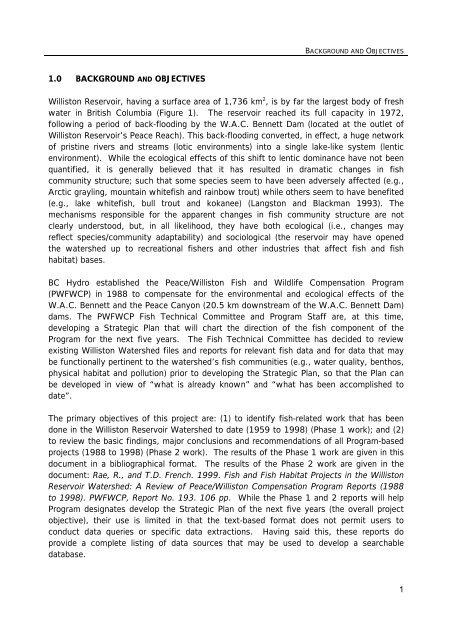WILLISTON RESERVOIR WATERSHED: FISH AND ... - BC Hydro
WILLISTON RESERVOIR WATERSHED: FISH AND ... - BC Hydro
WILLISTON RESERVOIR WATERSHED: FISH AND ... - BC Hydro
Create successful ePaper yourself
Turn your PDF publications into a flip-book with our unique Google optimized e-Paper software.
1.0 BACKGROUND <strong>AND</strong> OBJECTIVES<br />
BACKGROUND <strong>AND</strong> OBJECTIVES<br />
Williston Reservoir, having a surface area of 1,736 km 2 , is by far the largest body of fresh<br />
water in British Columbia (Figure 1). The reservoir reached its full capacity in 1972,<br />
following a period of back-flooding by the W.A.C. Bennett Dam (located at the outlet of<br />
Williston Reservoir’s Peace Reach). This back-flooding converted, in effect, a huge network<br />
of pristine rivers and streams (lotic environments) into a single lake-like system (lentic<br />
environment). While the ecological effects of this shift to lentic dominance have not been<br />
quantified, it is generally believed that it has resulted in dramatic changes in fish<br />
community structure; such that some species seem to have been adversely affected (e.g.,<br />
Arctic grayling, mountain whitefish and rainbow trout) while others seem to have benefited<br />
(e.g., lake whitefish, bull trout and kokanee) (Langston and Blackman 1993). The<br />
mechanisms responsible for the apparent changes in fish community structure are not<br />
clearly understood, but, in all likelihood, they have both ecological (i.e., changes may<br />
reflect species/community adaptability) and sociological (the reservoir may have opened<br />
the watershed up to recreational fishers and other industries that affect fish and fish<br />
habitat) bases.<br />
<strong>BC</strong> <strong>Hydro</strong> established the Peace/Williston Fish and Wildlife Compensation Program<br />
(PWFWCP) in 1988 to compensate for the environmental and ecological effects of the<br />
W.A.C. Bennett and the Peace Canyon (20.5 km downstream of the W.A.C. Bennett Dam)<br />
dams. The PWFWCP Fish Technical Committee and Program Staff are, at this time,<br />
developing a Strategic Plan that will chart the direction of the fish component of the<br />
Program for the next five years. The Fish Technical Committee has decided to review<br />
existing Williston Watershed files and reports for relevant fish data and for data that may<br />
be functionally pertinent to the watershed’s fish communities (e.g., water quality, benthos,<br />
physical habitat and pollution) prior to developing the Strategic Plan, so that the Plan can<br />
be developed in view of “what is already known” and “what has been accomplished to<br />
date”.<br />
The primary objectives of this project are: (1) to identify fish-related work that has been<br />
done in the Williston Reservoir Watershed to date (1959 to 1998) (Phase 1 work); and (2)<br />
to review the basic findings, major conclusions and recommendations of all Program-based<br />
projects (1988 to 1998) (Phase 2 work). The results of the Phase 1 work are given in this<br />
document in a bibliographical format. The results of the Phase 2 work are given in the<br />
document: Rae, R., and T.D. French. 1999. Fish and Fish Habitat Projects in the Williston<br />
Reservoir Watershed: A Review of Peace/Williston Compensation Program Reports (1988<br />
to 1998). PWFWCP, Report No. 193. 106 pp. While the Phase 1 and 2 reports will help<br />
Program designates develop the Strategic Plan of the next five years (the overall project<br />
objective), their use is limited in that the text-based format does not permit users to<br />
conduct data queries or specific data extractions. Having said this, these reports do<br />
provide a complete listing of data sources that may be used to develop a searchable<br />
database.<br />
1
















